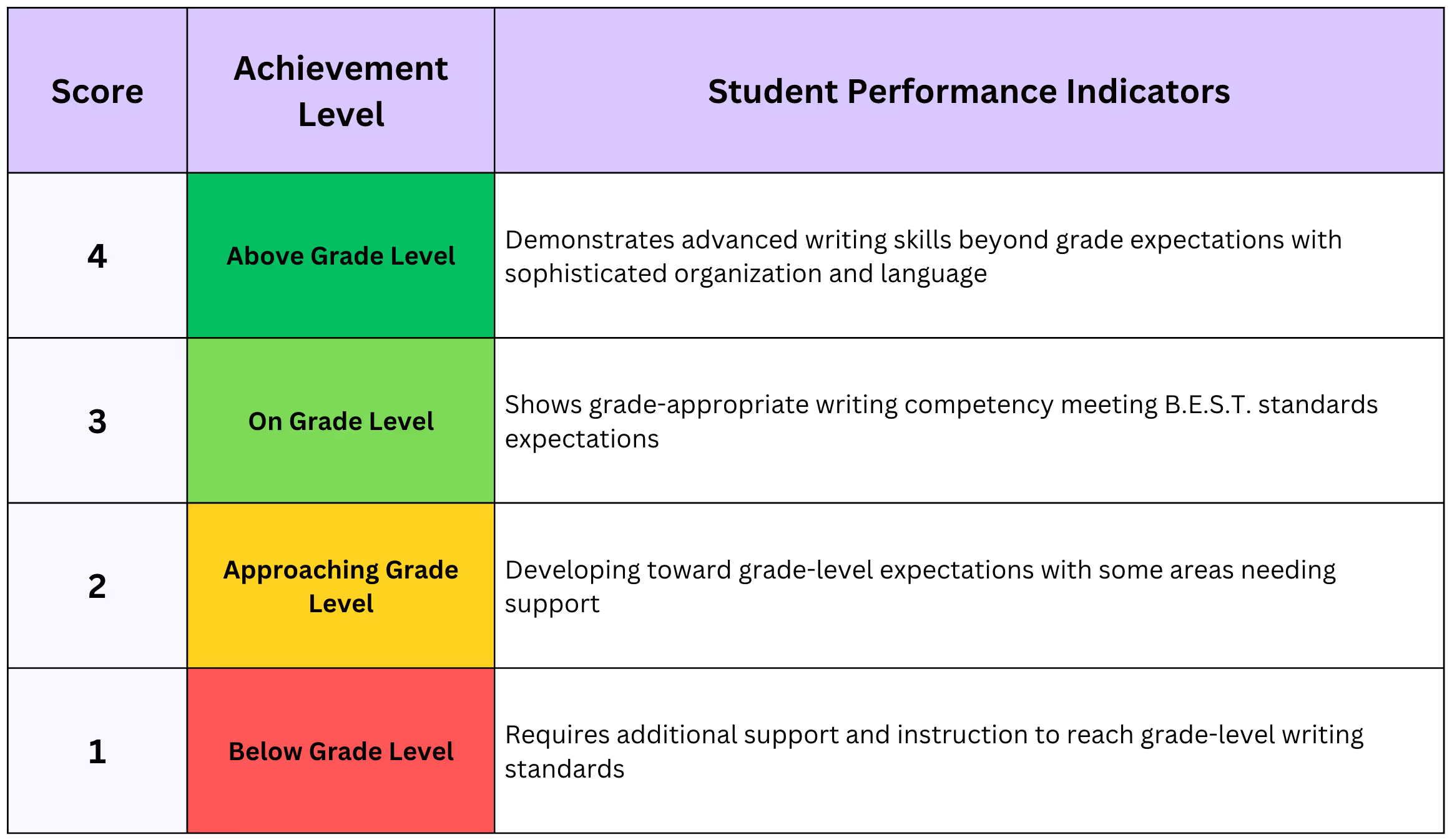Florida B.E.S.T. Writing Rubric Overview
The Florida B.E.S.T (FAST) writing rubric assessment evaluates students in grades 4-10 using computer-based, text-based writing prompts. Florida's writing assessment is administered once per year during spring testing and uses the state's official B.E.S.T. standards.
.avif)
Key Details:
- Grades: 4-10
- Administration: Spring (once yearly)
- Format: Computer-based with text-based prompts
- Writing Types: Expository and Argumentative
- Grade Bands: 4-6 and 7-10
- Scoring: 4-point scale across three domains
Free B.E.S.T Rubric Grading Tool
We’ve developed an AI grading platform that allows you to grade an entire class's essays in 2 minutes or less using Florida's official B.E.S.T (FAST) writing rubric. Try it out for free below.

Official Florida B.E.S.T Writing Rubrics
Grades 4-6 Rubrics
Grades 7-10 Rubrics
These official rubrics from the Florida Department of Education provide detailed scoring criteria for each domain and performance level. Teachers can download these PDFs for classroom use and reference during instruction.
How to Score Writing Using the Florida B.E.S.T rubric
Florida's B.E.S.T (FAST) writing rubric uses a 4-point holistic scoring system across three domains. Teachers score each domain separately, with responses earning scores by demonstrating most descriptors in a given score point.
Scoring domains:
- Purpose/Structure: Organization, central idea/claim development, transitions, introduction/conclusion effectiveness
- Development: Evidence use, elaboration techniques, topic understanding, source integration and citation
- Language: Vocabulary precision, sentence variety, grammar conventions, tone appropriateness
B.E.S.T (FAST) Scoring Chart

Important B.E.S.T Scoring System Rule: Without appropriate citations, the maximum Development score is 2, regardless of other criteria met.
Florida B.E.S.T (FAST) Grading Scale Differences by Writing Type
Expository writing focuses on explaining or informing:
- Central idea advancement through evidence
- Evidence should "lend credibility to the exposition"
- Sources support explanation and analysis
Argumentative writing focuses on persuading or convincing:
- Claim/position development through reasoning
- Evidence should "lend credibility to the argument"
- Grades 7-10 require counterclaims (optional in grades 4-6)
Florida Writing Assessment Achievement Levels

Important B.E.S.T Scoring System Rule: Without appropriate citations, the maximum Development score is 2, regardless of other criteria met.
Sample Student Work and Resources
Benefits of EssayGrader
Time efficiency & streamlined grading
Simplify and speed up the grading process with intuitive features, allowing you to focus on impactful teaching.
Consistency
& fairness
Ensure fair and accurate grading by eliminating human bias, all while aligning with your curriculum standards.
Actionable insights
& feedback
Receive detailed feedback and growth insights on each essay and seamlessly share them with your students.
Less grading, more teaching
EssayGrader cuts down grading workload so teachers can focus on teaching the craft of writing instead of getting stuck in conventions and mechanics.
Better student outcomes
Students get consistent practice and instant feedback that helps them improve writing skills, build confidence, and prepare for timed assessments like AP exams.
Hours saved every week
Teachers save 5–6 hours a week on grading. That time can be redirected to lesson planning, one-on-one support, or simply reclaiming personal time.
What teachers say about EssayGrader
Frequently Asked Questions About Florida B.E.S.T Writing Rubric
Common questions teachers ask about the FL B.E.S.T rubric. Contact us if you don't see your question answered below.
Teachers often use "FAST writing rubric," but Florida's official writing assessment is called "B.E.S.T. Writing." There is no separate "FAST Writing" test - FAST refers only to Reading and Mathematics assessments.
Students can revise their work within the testing session, but once they submit their response, no further changes are allowed. The computer-based format includes basic editing tools like spell-check, but students should be taught to budget time for reviewing and revising before submission.
Students have up to 120 minutes to complete their writing response, including reading the source texts, planning, drafting, and revising. However, most students finish within 90 minutes. Teachers should practice timed writing sessions to help students manage their time effectively.
Students receive 2-3 source texts that may include articles, infographics, charts, or excerpts from longer works. All sources relate to the writing prompt topic, and students must cite evidence from these sources to earn full Development domain points.
Focus on explicit instruction in the three domains: teach organizational patterns and transitions (Purpose/Structure), practice integrating textual evidence with proper citations (Development), and emphasize academic vocabulary and sentence variety (Language). Regular practice with timed writing using similar prompts is essential.

















.avif)
.avif)
